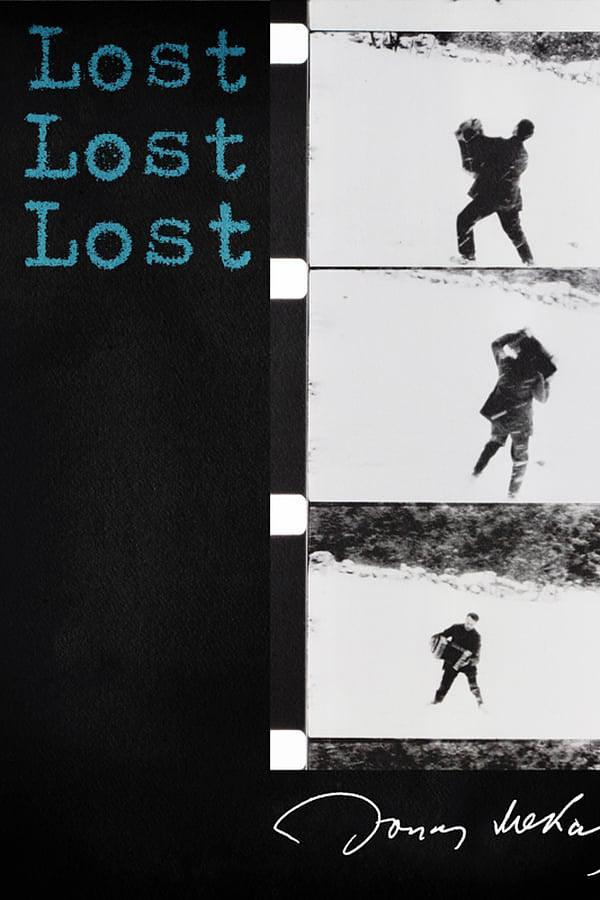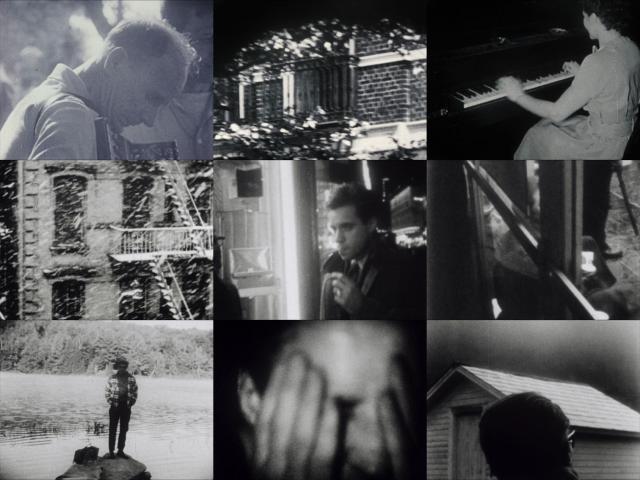|
|

译 名 失,失,失
片 名 Lost, Lost, Lost
年 代 1976
产 地 美国
类 别 记载片
语 言 英语
IMDb评分 7.7/10 from 333 users
IMDb链接 http://www.imdb.com/title/tt0209110
豆瓣评分 0/10 from 0 users
豆瓣链接 https://movie.douban.com/subject/4100796/
片 长 173分钟
导 演 乔纳斯·梅卡斯 Jonas Mekas
主 演 乔纳斯·梅卡斯 Jonas Mekas
阿道法斯·梅卡斯 Adolfas Mekas
肯·雅各布斯 Ken Jacobs
彼得?比尔德 Peter Beard
艾德·艾姆许维勒 Ed Emshwiller
标 签 美国 | 记载片 | JonasMekas | Jonas_Mekas | 乔纳斯·梅卡斯 | 1976 | 1970s | 美國
简 介
Walden may have been Mekas' first diary film, but the film that incorporated Mekas' earliest footage was the one that told the story of his postwar arrival in America, Lost Lost Lost. The film is divided into two parts: the first concerns life in the Lithuanian community of Williamsburg, and the second chronicles Mekas' move to Manhattan and his integration into the independent film and art scenes of New York.
Here Mekas is at his most deeply personal. He describes the loneliness and struggle of those early years with mournful music and spoken laments: “Long, lonely days; long, lonely nights. There was a lot of walking through the nights of Manhattan. I don't think I have ever been as lonely.” Mekas also closely follows the lives of his fellow Lithuanian immigrants. During a gathering in Connecticut, he explains, “occasionally we used to escape to Stonybrook, places where immigrants exchanged their memories. We all gathered there, we all lived on memories there.” As the first section progresses, however, a tension develops between Mekas and the other immigrants. Though Mekas sympathises with them, he grows increasingly disenchanted with their hopes to reform and return to Lithuania. By the end of the reel, he leaves the community in Williamsburg and moves to Manhattan.
These were our last times together. I began to feel that I had been turning on one spot around my memories. I began to feel if anything can be done for Lithuania, it can only be done by the people that live there. That the only way that I can be useful to Lithuania is by building myself from scratch, from the beginning, and then giving myself back to it, back to Lithuania, however I am.
Part two, the section entitled “Diaries, Notes, Sketches”, describes the beginnings of Mekas' involvement in the underground film community, and his gradual establishment of roots in Manhattan. It includes unfinished scenes from the first film that he and Adolfas worked on, a story about a woman who presages the death of her husband. This is also documentary footage of Mekas on the set of Guns of the Trees, standing with his arms crossed and jaw tensing, obviously uncomfortable. Living in New York and making friends, Mekas gains in enthusiasm: “It was exciting; everything was new.” Still, Mekas is a long way from the jubilant life portrayed in Walden. He admits, “there is very little known about this period of our protagonist's life. It's known that he was very shy and very lonely during this period. He used to take long, long walks. He felt very close to the parks, to the street, to the city.”
What dominates the second part of Lost Lost Lost is Mekas' imperative to film. He is drawn to the bravery of people who insist on being heard: the protesters gathered at City Hall, pamphleteers hailing a “New America”, and the leaflet women who stood outside on the coldest day of the year. With his camera-eye, he gives them the recognition they seek. “I have seen you, the leaflet women,” he calls. “They are known in rain, in snow, in cold, in hot summer days. I've seen you, the leaflet women.” As Mekas voices his salute in the moment of editing, however, it is decades later, long after the struggles themselves have been forgotten.
Moments later, he reveals a deeper motive for filming. “It's my nature now, to record. To try to keep everything I'm passing through, to keep at least bits of it. I have lost too much so now I have these bits that I have passed through.” The “too much” that Mekas refers to, his pre-war life and irretrievable childhood, resonate as loss in the images he does manage to collect. Mekas' insistence to film is directly tied to his need to hold onto the pieces of his life, so he will not lose any more than he already has.
The third reel contains the unfinished “Rabbit Shit Haikus”, vignettes filmed while Adolfas was shooting Hallelujah the Hills (1963). Here, Mekas tells the story of the rabbit shit at the end of the road, albeit a different and slightly darker version than the one that appeared in his journal, I Had Nowhere to Go (1944–1955). In a journal entry from December 30, 1951, the man who reached the fabled end of the world laughed when all he found was rabbit shit, realising the foolishness of his long years of effort. The Lost Lost Lost, version, however, told over twenty years later, describes what happened when the man returned home: no one believed him. The Rabbit Shit Haikus include 31 views of mostly natural subjects: trees, snowy landscapes, and the sky. Mekas introduces his subjects by speaking their names three times in a slow, incantatory cadence: “the sunset…the sunset…the sunset…” or “the childhood…the childhood…the childhood…”. He and Adolfas frolic in the snow like children. In one shot Jonas dances through the falling snow with his accordion. In another, Adolfas slides down into the semi-frozen river. Mekas was never completely satisfied with the “Rabbit Shit Haikus”, but nestled within Lost Lost Lost, even in their unfinished form, they give the film a sense of peace and simplicity not felt, perhaps, since Mekas first left Lithuania. In temperament, the “Rabbit Shit Haikus” have more in common with Mekas' later films about his family, Paradise Not Yet Lost and As I Was Moving Ahead. Their appearance in Lost Lost Lost, the film that concerns Mekas' difficult first years in America, offer an expression of hope for what could be.
Embedded in the images of Lost Lost Lost, there is also the story of a maturing filmmaker, who, in the beginning, poses awkwardly for test shots and uses a tripod for portraits in black and white. By the end, Mekas has begun to perfect his technique. Late in the film, Mekas describes a scene at a film seminar at Flaherty where he and Ken Jacobs were denied entry. They sleep outside, in the bed of their truck, and awake to a cold, foggy morning in a vast field. Mekas uses some of Jacobs' footage to show himself with a blanket wrapped around his shoulders, guiding his Bolex in wide, looping gestures. Then he cuts to the footage he was shooting. It is as if Mekas' camera loosens. We see momentary bursts of single frames, the rapid and blurry motion of his camera interrupted by startling detail of the wildflowers in the grass. This is the first instance of what would become recognisable as Mekas' signature style, and its realisation at Flaherty, where the established film community had rejected him, coincides perfectly with the emergence of a distinctive way of seeing.
The last scenes in the film occur at a beach in Stonybrook, where Mekas had been ten years before with the Lithuanian émigrés. As he films his friends wading in the water, he realises that he had been on the beach before. “I have been here before. I have really been here before”, he says with some amazement. As his filmic restoration of Lithuania in Reminiscences allowed him to move forward on the path he should have gone (i.e. to Vienna), the recognition of the beach at Stonybrook gives him a sense of fixity in an otherwise uncertain fate.
Lost Lost Lost, though it contains Mekas' earliest footage, was edited only after Mekas saw his community blossom in Walden, and after he had regained his homeland in Reminiscences. It is as if the painful themes of exile and loss could only be explored after a considerable length of time had lapsed, though in reviewing his filmed memories, it is clear that they were never entirely gone. In one telling scene he looks at his friend filmmaker Barbara Rubin's hair as she sits beside a fountain. Perhaps recognising a hairstyle from long ago, he interjects, “No, no he won't look back.” Mekas pulls away, turning his attention to “the unpredictable and unknown” as the image of a woman's face appears, engulfed by enormous bubblegum balloons.
- Video
- ID : 1
- Format : AVC
- Format/Info : Advanced Video Codec
- Format profile : <a href="/cdn-cgi/l/email-protection" class="__cf_email__" data-cfemail="c78faea0af878bf3e9f6">[email protected]</a>
- Format settings : CABAC / 4 Ref Frames
- Format settings, CABAC : Yes
- Format settings, Reference frames : 4 frames
- Codec ID : V_MPEG4/ISO/AVC
- Duration : 2 h 53 min
- Bit rate : 10.2 Mb/s
- Width : 1 440 pixels
- Height : 1 080 pixels
- Display aspect ratio : 4:3
- Frame rate mode : Constant
- Frame rate : 23.976 (24000/1001) FPS
- Color space : YUV
- Chroma subsampling : 4:2:0
- Bit depth : 8 bits
- Scan type : Progressive
- Bits/(Pixel*Frame) : 0.274
- Stream size : 12.4 GiB (87%)
- Writing library : x264 core 157 r2969 d4099dd
- Encoding settings : cabac=1 / ref=4 / deblock=1:-3:-3 / analyse=0x3:0x133 / me=umh / subme=9 / psy=1 / psy_rd=1.00:0.00 / mixed_ref=1 / me_range=16 / chroma_me=1 / trellis=2 / 8x8dct=1 / cqm=0 / deadzone=21,11 / fast_pskip=0 / chroma_qp_offset=-2 / threads=18 / lookahead_threads=1 / sliced_threads=0 / nr=0 / decimate=1 / interlaced=0 / bluray_compat=0 / constrained_intra=0 / bframes=3 / b_pyramid=2 / b_adapt=1 / b_bias=0 / direct=3 / weightb=1 / open_gop=0 / weightp=2 / keyint=240 / keyint_min=24 / scenecut=40 / intra_refresh=0 / rc_lookahead=50 / rc=2pass / mbtree=1 / bitrate=10225 / ratetol=1.0 / qcomp=0.60 / qpmin=0 / qpmax=69 / qpstep=4 / cplxblur=20.0 / qblur=0.5 / ip_ratio=1.40 / aq=1:1.00
- Language : English
- Default : Yes
- Forced : No
- Audio
- ID : 2
- Format : DTS
- Format/Info : Digital Theater Systems
- Codec ID : A_DTS
- Duration : 2 h 53 min
- Bit rate mode : Constant
- Bit rate : 1 509 kb/s
- Channel(s) : 2 channels
- Channel layout : L R
- Sampling rate : 48.0 kHz
- Frame rate : 93.750 FPS (512 SPF)
- Bit depth : 24 bits
- Compression mode : Lossy
- Stream size : 1.83 GiB (13%)
- Language : English
- Default : Yes
- Forced : No
- Text
- ID : 3
- Format : UTF-8
- Codec ID : S_TEXT/UTF8
- Codec ID/Info : UTF-8 Plain Text
- Duration : 2 h 52 min
- Bit rate : 14 b/s
- Count of elements : 624
- Stream size : 18.1 KiB (0%)
- Title : English
- Language : English
- Default : No
- Forced : No
- Menu
- 00:00:00.000 : en:00:00:00.000
- 00:14:22.862 : en:00:14:22.862
- 00:32:04.548 : en:00:32:04.548
- 00:43:09.629 : en:00:43:09.629
- 00:49:55.159 : en:00:49:55.159
- 00:59:51.213 : en:00:59:51.213
- 01:15:28.774 : en:01:15:28.774
- 01:32:45.393 : en:01:32:45.393
- 01:45:37.873 : en:01:45:37.873
- 01:57:31.878 : en:01:57:31.878
- 02:01:18.605 : en:02:01:18.605
- 02:13:43.057 : en:02:13:43.057
- 02:26:23.608 : en:02:26:23.608
- 02:37:49.585 : en:02:37:49.585
- 02:44:19.141 : en:02:44:19.141

 Lost.Lost.Lost.1976.1080p.BluRay.x264-BiPOLAR.torrent
(71.91 KB, 下载次数: 12, 售价: 2 枚蓝光币)
Lost.Lost.Lost.1976.1080p.BluRay.x264-BiPOLAR.torrent
(71.91 KB, 下载次数: 12, 售价: 2 枚蓝光币)
|
|